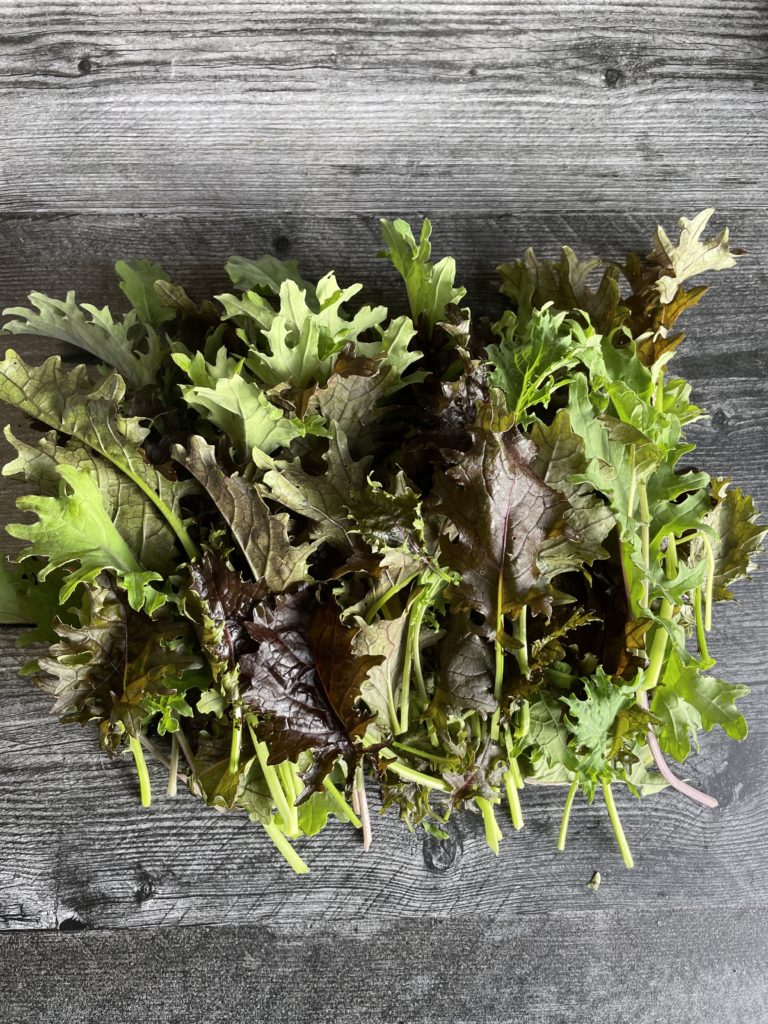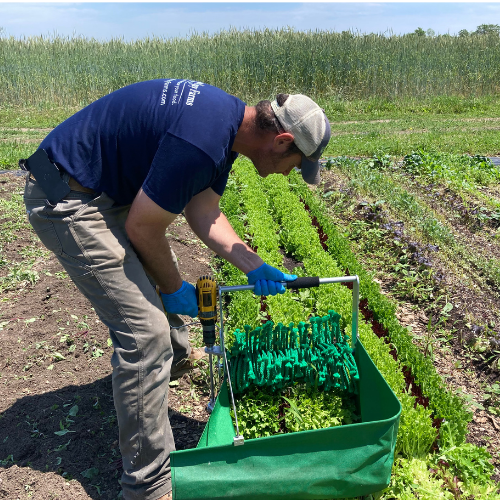CSA Newsletter Week 15 (Sept 26- 30, 2022)
CSA Newsletter Week 15
Sept 26-30, 2022 | “A” Week
Our CSA is an 18 week season.
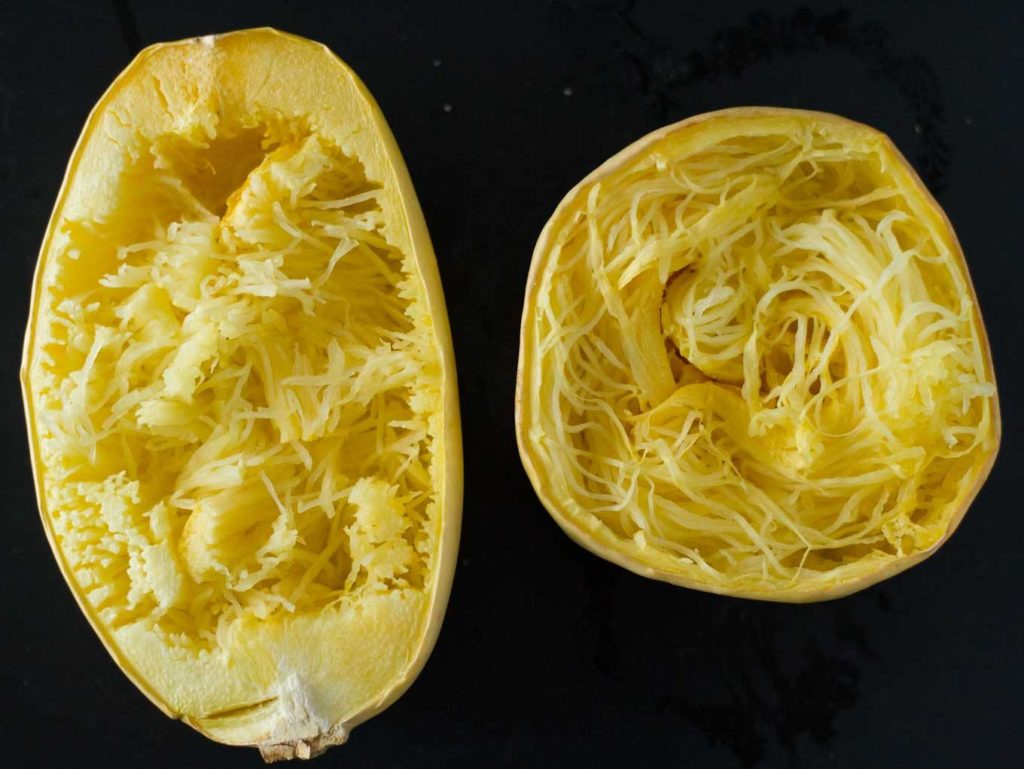
This is the inside of a spaghetti squash. If you cut it along the waist or the belly button of the squash, you will have longer strands as a result.
What’s in the Box this Week?
SPAGHETTI SQUASH (1) ~ This variety of winter squash has unusual string-like flesh, which looks like spaghetti when scraped out with a fork. They are often baked or boiled and then the mildly sweet flesh is scooped out and topped with spaghetti sauce. To store: Store in a cool, dry, dark place at around 50 degrees, but make sure they do not freeze. To prep: Stand the squash up and slice in half lengthwise around the “belly-button.” Scoop out seeds. To use: To bake, place squash halves facedown on a cookie sheet. Add a 1/2 inch water to the pan to avoid drying out. Bake at 400 degrees. Squash will need about an hour— 90 minutes to cook, depending on size. Cook until tender. Flesh is done when it scoops out easily in spaghetti-like strings with a fork. Serve hot with butter and parmesan cheese or your favorite tomato sauce on top. To freeze: Let the cooked squash cool to near room temperature and then transfer the noodles to Ziplock freezer bags. Store for up to 8 months in freezer.
LEEKS (1 small bunch) ~ To store: Cut off the green tops (save those greens and put them in your veggie freezer bag to make veggie stock). Loosely wrap unwashed leek bottoms (with roots attached) in a plastic bag and store them in the crisper drawer of your refrigerator where they will keep for 2 weeks. To prep: Cut the leek about 1 inch above the white part, where the leaves begin changing from dark to light green. Save the unused greens; they’ll give great flavor to your next vegetable stock. Slit the leek lengthwise and soak it in lukewarm water for 15 minutes. Fan the leaves under running water to dislodge dirt, then pat dry. chop the white part of the allium finely. To use: Use leeks in salads, casseroles and soups or wherever you’d use onions. They can be braised, boiled grilled, or steamed. To freeze: Cut the white parts of the leek into slices and flash freeze in Ziplock bags.
BABY KALE MIX – 0.4 lb (salad greens) ~ Store unwashed lettuce in a plastic bag in the refrigerator. To store lettuce that you have already washed and dried with a spinner, place back in a plastic bag with a dry paper towel in the bag, and place the package in the vegetable crisper bin. Use within 4 days.
POBLANO PEPPERS (5) ~ These peppers have a mild heat to them, and are used for Tex-Mex cooking! To store: Refrigerate peppers unwashed in a sealed plastic bag in the crisper drawer for 1-2 weeks. To prep: Cut in half and remove the seeds from the inside. Slice, chop or mince. To use: Try roasting peppers over a flame until the skin blackens. Place the pepper inside a plastic bag to cool. Then remove to slide off the skins. To freeze: Wash and dry peppers. Freeze whole or cut into bite-size pieces and place in Ziplock freezer bag, removing as much air as possible.
TOKYO BEKANA GREENS ~ This will be a lime-colored green from the cabbage family — although it looks like a tall head lettuce. Store unwashed in a plastic bag in the refrigerator. Use within 4 days. Wash well before use and spin dry.
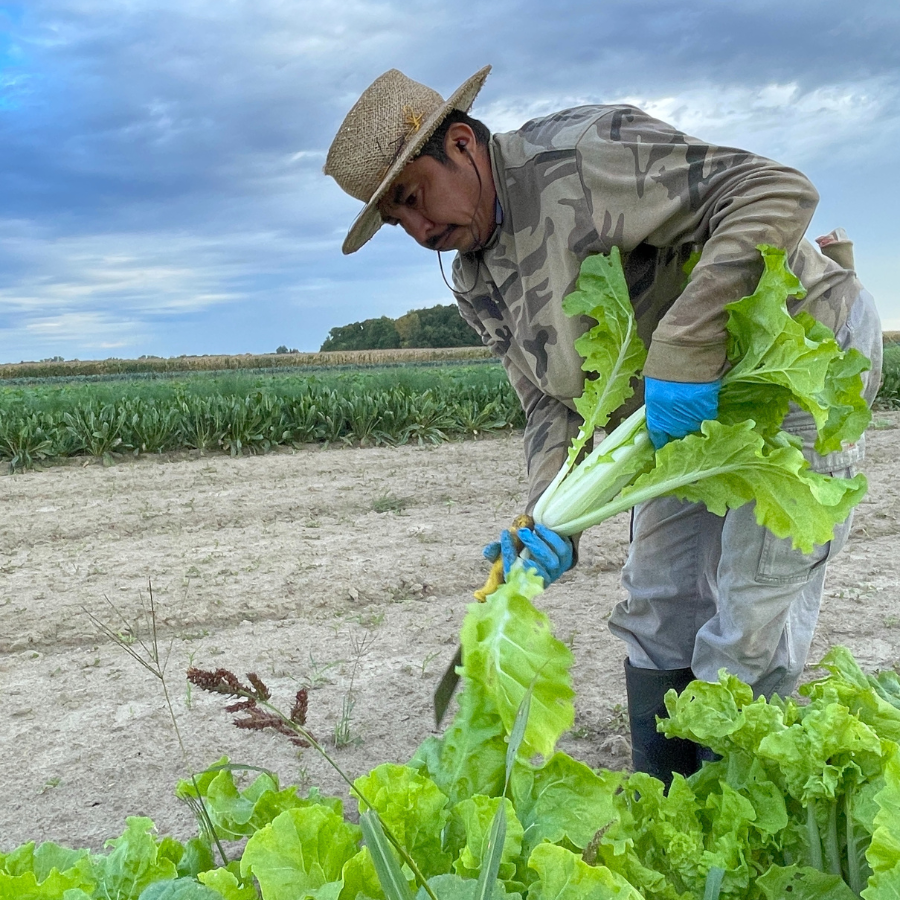
Polo harvests this week’s Tokyo Bekana greens.
POTATOES – 1 QT (from Mile Creek Farm) ~ To store: Keep unwashed potatoes in a cool, dark, dry place, such as a loosely closed paper bag in a cupboard. They will keep for two weeks at room temperature. Light turns them green, and proximity to onions causes them to sprout. Don’t put them in the refrigerator, as low temperatures convert the starch to sugars. To prep: Scrub well and cut off any sprouts or green skin. Peeling is a matter of preference. In soups, the skins may separate from the flesh and float in the broth, but when baked, pan- fried or roasted, the skins acquire a crisp, crunchy texture. To cook: Boil potatoes in water for 20-30 minutes until tender. If desired, mash them. Use potatoes in soups, hash browns, and salads. Roast sliced or whole small potatoes with fresh herbs, salt, and olive oil at 400 degrees until tender, about 20 minutes.
YELLOW ONIONS (3) ~ To store: Red and yellow storage onions may be kept in any cool, dark, dry place with adequate air circulation for several months if they are cured. Do not store them next to potatoes. Fresh onion will need to be stored in a plastic bag in the fridge and use within 2 weeks. To prep: Peel the onion’s skin and cut off the roots and top. Save your papery onion skins in a bag in your freezer reserved for making vegetable stock. If you encounter a little rot in your onion, just cut away the bad sections. If there are a few black spots, rinse the whole onion in cool water and rub the spots off with your thumbs. To freeze: Cut or slice onions to desired size and place in freezer Ziplock bag. Remove all the air and seal. It helps to freeze them in 2-3 cup increments.
CURED GARLIC (1) ~To prep: Remove the papery skin and base. Mince or chop as needed. To cook: For garlic aroma, try rubbing a cut clove around the rim of a baking dish. Try roasting garlic: cut tops off garlic to expose cloves, brush with olive oil, and bake for 1 hour at 350 degrees. Squeeze garlic out of its skins and spread on crusty bread. To freeze: Leave the skins on and place individual cloves in a Ziplock bag or Mason jar; then freeze.
KOHLRABI with tops (2 medium) ~ This plant was developed by crossing a cabbage with a turnip! The edible part of the plant is an enlarged section of the stem that develops just above the ground. It has a crisp interior like a potato. To store: Store kohlrabi globe and leaves separately. The bulb will last for 2 weeks refrigerated in a plastic bag. Wrap leaves and stalks in a plastic bag and keep in the crisper drawer of the refrigerator. To prep: Rinse under cold running water just before use. Cut the outer skin off with a knife. Trim off the remains of the stalks and root. Grate, slice, or chop as desired. To cook: Cut raw kohlrabi bulb into sticks for a refreshing addition to a raw vegetable tray or grate it for salads. Try raw kohlrabi smeared with peanut butter. Lightly boil, steam or bake it, or add it to stews and stir-fries. Young kohlrabi leaves can be used in recipes calling for greens. To freeze: Cut into cubes or slices and blanch for 3-4 minutes. Place into ice water bath to stop the cooking. Drain and dry. Place in Ziplock freezer bag.
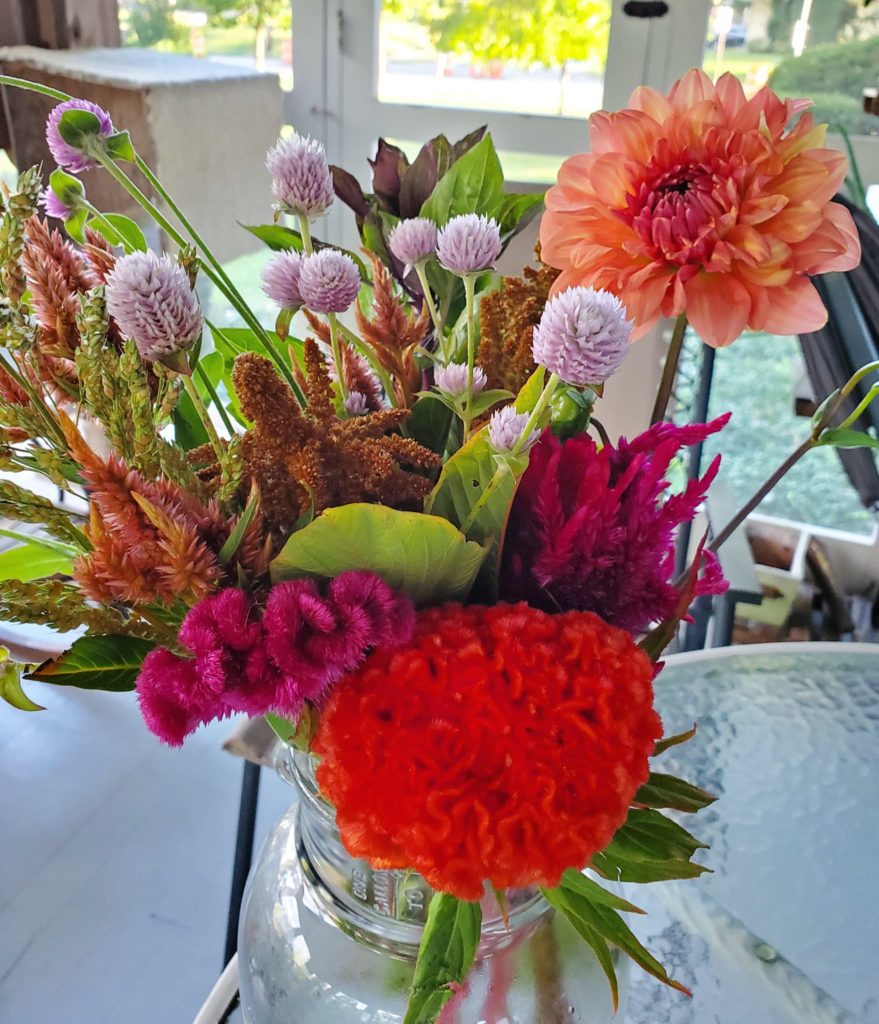
Danielle Kuhl has been taking beautiful pictures of our flower bouquets each week! Clay Hill Farm provides these blooms.
WEEK #15 ADD-ON SHARES: Week “A”
Odd-numbered weeks of our CSA season (week 1,3,5) are called “A” weeks. And even-numbered weeks (week 2,4,6) are called “B” weeks. If you have any kind of non-veggie, bi-weekly share, you have been assigned to either “A” or “B” week for the season. If you get a cheese share, it always comes on Week “A.”
WEEK 15 FRUIT SHARE:
Remember, the fruit share is a 16-week product. This is the FINAL week for bi-weekly “WEEK A” fruit share members.
FUJI APPLES (Quarry Hill) ~ Delicious apple for eating out of hand, or baking! Store in a plastic bag in your fridge, where they’ll keep for 4-5 weeks!
APPLE CIDER, half-gallon (Quarry Hill) ~ Store your apple cider in the fridge (obviously), and drink within 10 days.
BOSC PEARS (Quarry Hill) ~ These pears have a brown skin, and are delicious when poached! Pears are picked unripe and ripen best at home off the tree. You should always purchase pears that are firm to the touch. A ripe pear will be ready at home when the skin around the neck gives to slight pressure. Note: Cut pears will turn brown when exposed to air. Coat them with lemon juice to prevent this. To store: To ripen pears, place in a loosely closed paper bag out of the fridge at room temperature until the skin responds to a gentle pressure at the neck of the fruit. After pears have ripened, store them in a plastic bag in the fridge in your crisper drawer.
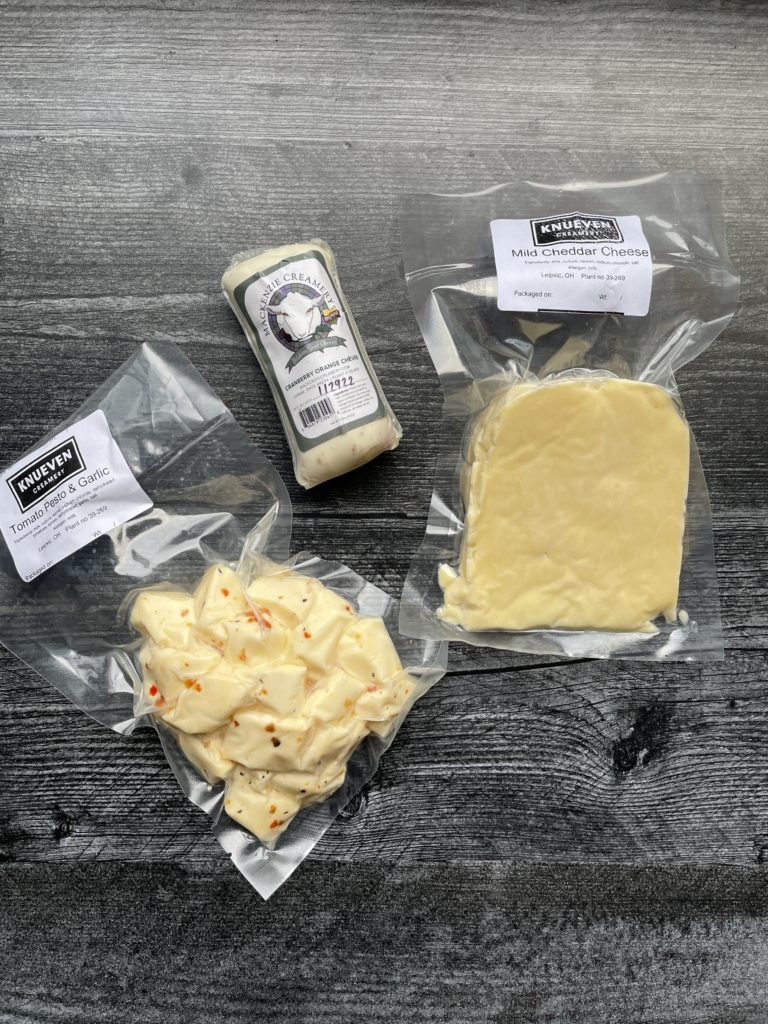
Week 15 cheese share
Cheese of the Week:
Tomato Pesto & Garlic Cheese curds, and Mild Cheddar (KnuevenCreamery.com)
Cranberry Orange Chevre (MackenzieCreamery.com)
Ice Cream Flavor of the Week:
Pumpkin Spice from Knueven Creamery. Note: be sure to stop and pick up your ice cream from the Knueven milk truck at your pickup site! They will be located either right before or after your veggie pickup. Your farmers will not be passing this out in their delivery line.
Coffee Flavor of the Week:
Guatemala Antigua: Maddie & Bella Coffee Company aromatic, sweet, spicy
How We Harvest Greens FAST on the farm!
Many years ago, we used to harvest cut greens with a paring knife.
No joke. It would take FOREVER to harvest 10 pounds of spinach in our high tunnel, or any kind of kale mix. In fact, it would take so long, we often didn’t include those products in our CSA share.
Then after a few years, we invested in a special greens harvester from Johnnies that had a long serrated blade attached to a red bag that would catch the greens as you went along. Kurt would do a few shakes of the wrist as he bent over the bed and grab the greens that way.
That was much faster.
Then we saw this…
It’s called the Farmers’ Friend, and it hooks up to a drill to power it. (Hilarious, right?) Corinna splurged one year and bought this for Kurt’s birthday. (I know… so romantic). Now greens harvesting is even easier and faster!
We sometimes harvest the greens a few days before pack day, because A.) they’re ready, and we don’t want them to get too big and B.) the weather forecast is calling for rain. The ideal conditions for harvesting cut lettuce is early morning just after the dew has disappeared.
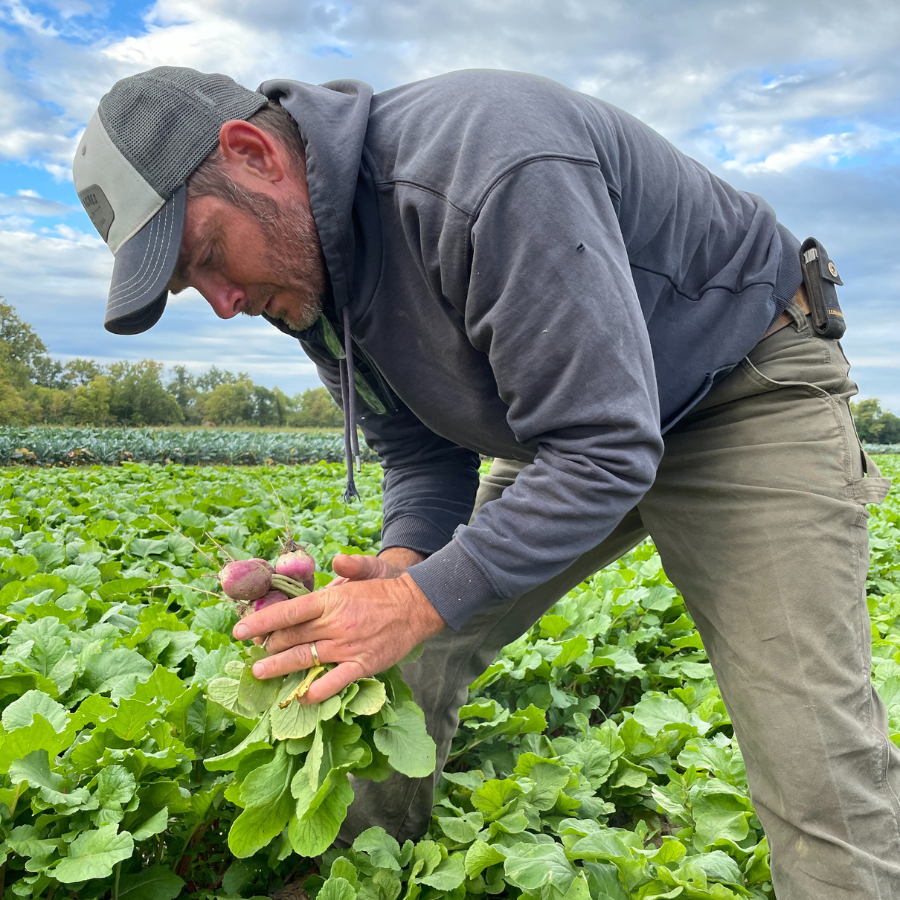
Kurt takes a look at the Diana radishes to see if they’re up to size.
FARMER KURT’S FIELD NOTES
Many thanks for all the birthday wishes and gifts! From my birthday-boy-blue-ribbon to the bottle of whisky, the hand pies, cupcakes, cards, beer cans, and gift certificates to Benchmark (woah!) — I was feeling the love. I am a lucky man.
This week, we started pulling poly off of Dad’s melon beds. There’s a LOT of it, and I still have more to go. Melon season is officially over. Sweet corn is almost done as well. I may squeak 2 more weeks by, but we usually shut that down by early October. This will also be the absolute last week for tomatoes. If you want some for canning, head to the store.
The old sweet corn fields were turned into fodder for Adam our neighbor this week. Glen helped chop those up. It feels good to see the fields clearing out. I’m getting my view back. I’ve still got a nice crop of organic soybeans, which are going for a great price this season. Soon I’ll be able to harvest those as well.
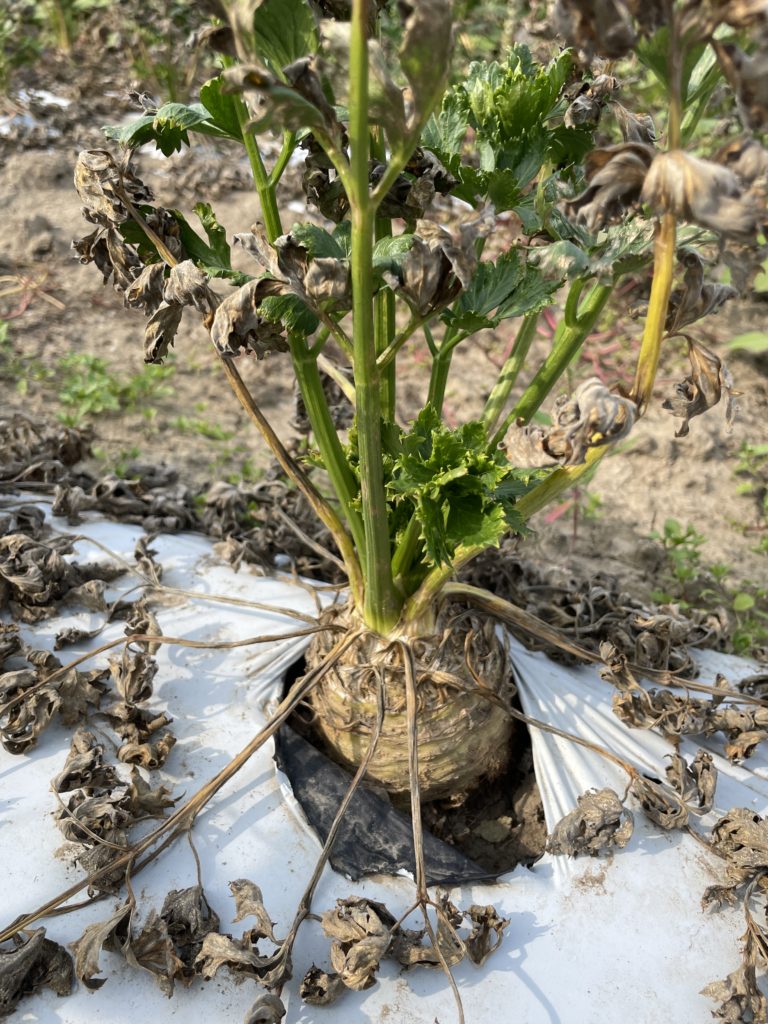
What is THAT!?? This is a celery root also called celeriac), and we will be putting this in the box very soon! You eat the root part! You cut off the gnarly ugly brown skin and inside is a concentrated celery flavor. These store in your fridge for up to 6 months!
My crew did a fair amount of weeding for fall crops — the beets needed it bad. The winter squash has been harvested and is curing in the cold frame. I’ve got a few new varieties this year — one is a cream-colored acorn squash variety. And I’ve also grown some mini butternuts. I also spent some time working the clover field — I want the clover to die back so that it will put its nutrients into my soil for next season’s bounty. I do love my tractor work!
You’ll see a new green this week called Tokyo Bekana. Well, I guess it’s not really new. We had it once last year. But I remember you guys really liked it! I tried growing it this spring and it failed.
I sold a big wholesale order of cauliflower this week. Don’t worry! I have more in the pipeline for you. It was ready to pick on Wednesday last week, and when cauli is ready to go, you’ve got to pick it and move it fast. I remember the days when I had trouble with this crop. But now, thanks to my soil rotation and taking good care of my soil mix, things are growing they way they should.
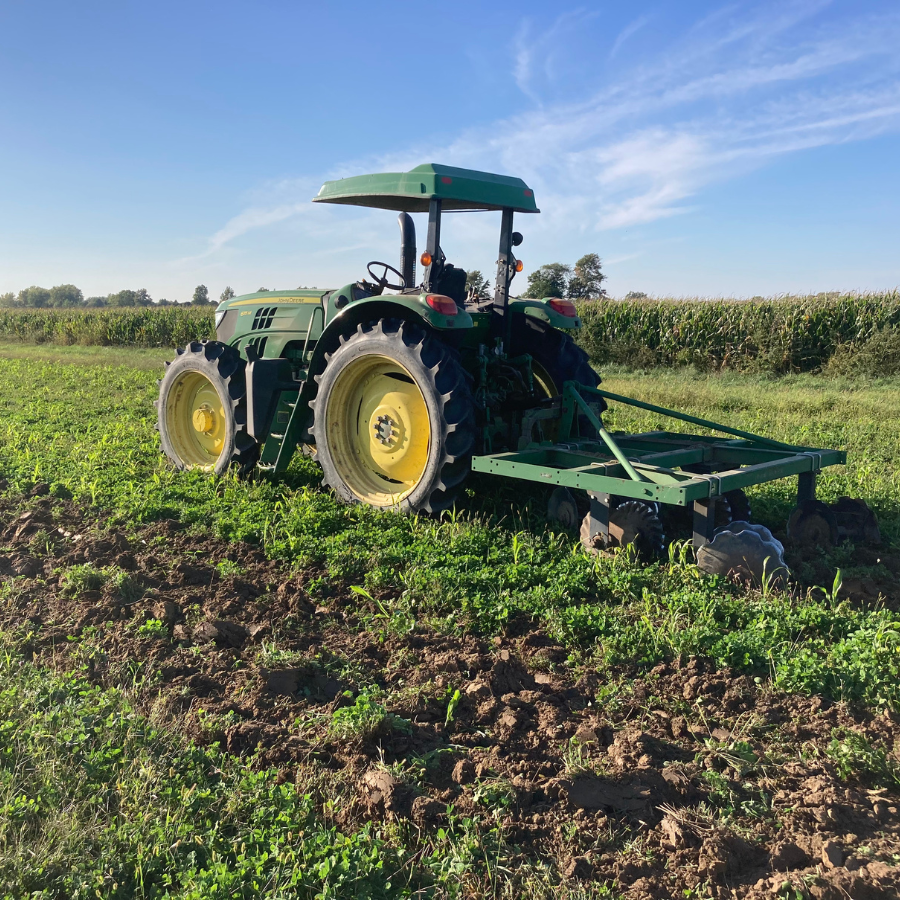
Kurt kills the clover cover crop (on purpose). This valuable nutrient-dense crop will decompose in the soil and add all kinds of plant power!
We also hosted a representative from the “Real Organic Project” this Friday. She came out inspect our operation. We are trying to get this accreditation/seal for our farm. It’s technically considered by some as “better than” USDA Certified Organic, because it requires the use of soil to be considered organic. (Aquaponic farms can technically be certified organic, but true organic farmers claim that in order for it to be organic, your product must come from the soil.) We passed the inspection, so we’ll be adding that seal to our marketing shortly!
Corinna hosted a webinar for 250 farmers from around the nation on “How to Plan a Farm Dinner Event” — she is quite the influencer these days. I’m so proud of how she is making a difference in the CSA farming industry and trying to pass on what we’ve learned to other local farms. You should listen to her podcast sometime! It’s called My Digital Farmer. In fact, this past week, she released a podcast where she interviewed our CSA Coach Cadie Jardin. It’s really good! You can listen here.
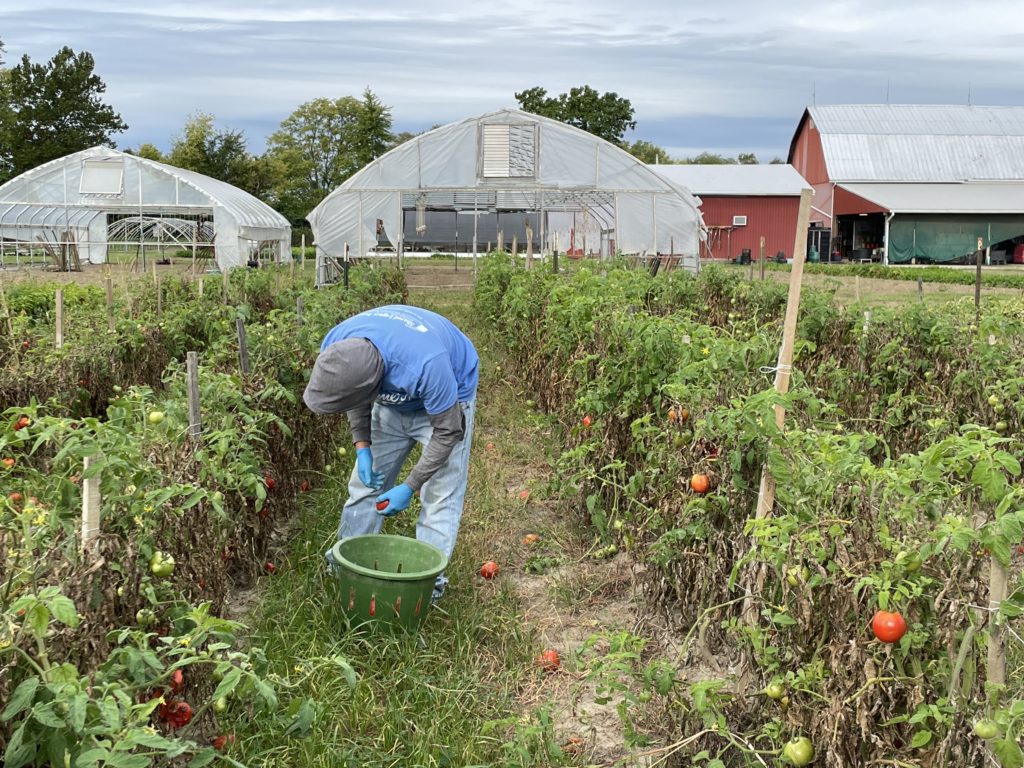
Pedro picks through the last vestiges of the tomatoes.
I took my boys to Tatum Park — an urban garden program in Toledo run by Sonia from Urban Wholistics. My big project this summer has been to get their high tunnel up and safely secured before winter winds and temperatures descend. We move it to a new spot on Saturday morning and put a tarp underneath it to kill the grass. Next step is to anchor it — hopefully that will be done in 2 weeks.
I wanted to say thank you to Kaleigh Fox, a high schooler who picks up at our Elmore site each week. She is a really good artist, and she surprised Corinna this week with an original print of Harley. I’ll put the picture below. We were both really struck at the generosity and thoughtfulness (as well as the talent) she displayed. So Kayleigh — thank you!
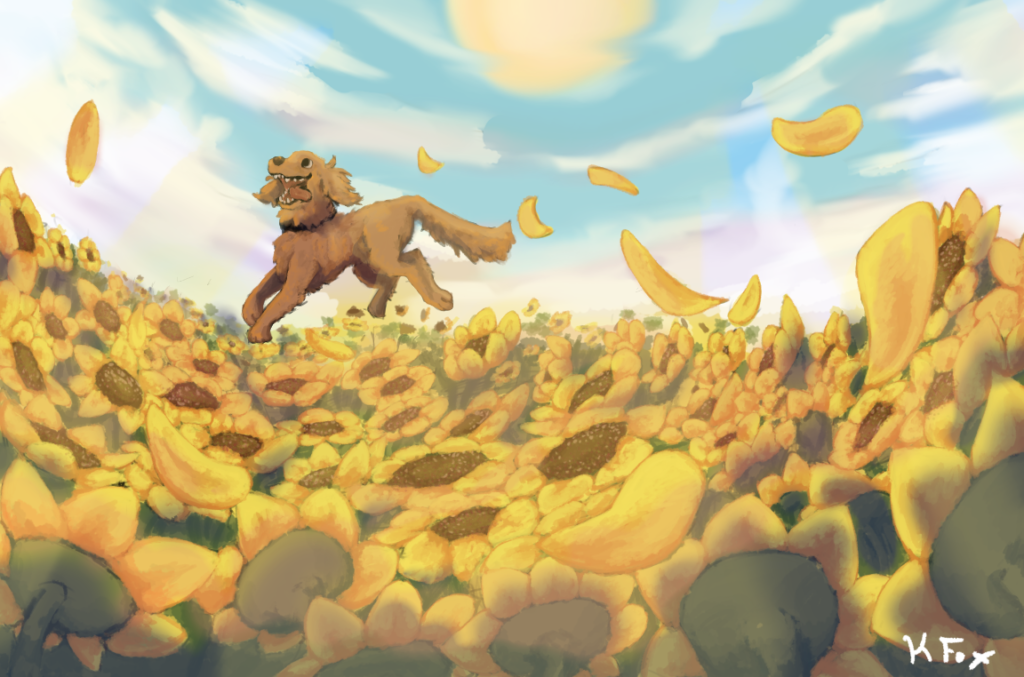
This picture was made by high schooler Kayleigh Fox for us this past week, as a momento of Harley.
My mom went in for a hip replacement surgery this Friday. It was very sudden, and we’re lucky she got in when she did. She’s been in a lot of pain the last few months. Everything went well, and we’re heading over to her house tonight for my birthday celebration.
~Your farmer, Kurt
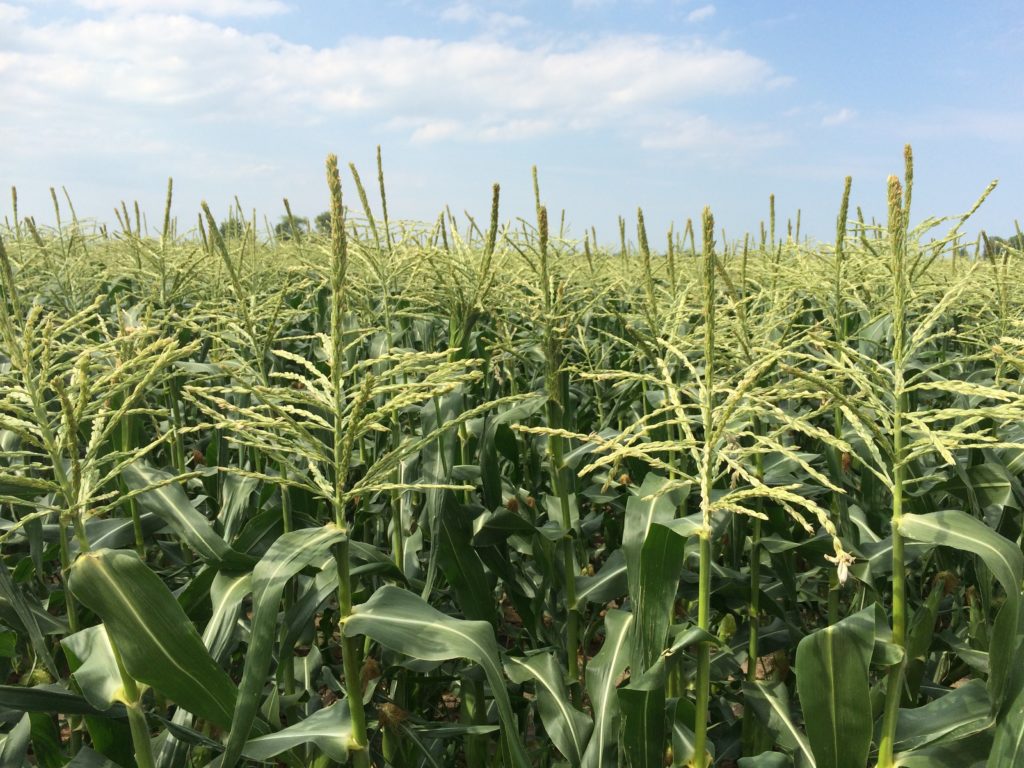
This sweet corn is tasseling. But in the fall, the stalks are dried up and useless. Or are they?… Our neighbor chops them up and uses them to feed his cows.
Zero Waste: How We Use Every Part of the Corn Plant
This past week, Adam (our neighbor) could be seen driving over the “old” sweet corn plants with a special machine that chops up all of the stalk and spits out out behind. This is corn fodder, and Adam feeds it to his cows. Cattle farmers spend a lot of the summer months growing feed for their animals to last through the winter. One of the food stuffs Adam uses is the chopped-up corn stalks. This includes the leaves, stalks, and cobs — whatever is left over after harvest. (We call this leftover corn stuff “residue.”)
First Adam drives a giant shredder over the fields to cut the stalks and place them into windrows. (Windrows is the term used to describe the rows of fodder or straw that lay on the ground to dry before they are baled). A shredder is basically a giant mower, with two spinning blades that chop the plant. Then after the stalks dry in their windrows, Adam drives a tractor and baler over the fields, collecting the fodder into giant bales of corn stalks. These are then loaded onto a trailer with a skid-steer, and carried over to Adam’s barn for winter storage.
It’s always a gamble because sometimes the weather doesn’t cooperate. If a heavy rain event falls on the cut corn stalks after they are cut, they will mold and rot, resulting in a loss. Adam got a healthy bounty off the fields — plenty of food for his cows to munch on. This is one way that farmers make use of every part of the plant.
But it helps the farmers too. Field corn is the last crop in the field rotation plan before vegetables are planted. (The annual rotation is: field corn, bedded vegetable crops, sweet corn, rye, soy beans). Vegetable farmers don’t want a lot of residue in the soil right before a bedded vegetable crop because it doesn’t break down fast enough and makes it hard to plant into. So it helps them if they can get rid of some of the residue and purpose it elsewhere. Farmer Kurt will help his dad disc up the remaining stubble and put beds up for next year’s crops.
RSVP FOR THE PUMPKIN HUNT
Sat.,October 8th, 2023, 7:30-9:00 PM | FREE FOR MEMBERS
Bring your kids to the farm for our annual “Flashlight Pumpkin Hunt.” How does it work? This is a kid-friendly event and it’s FREE for all CSA members. We hide 10 pumpkins around our house in the darkness. Each pumpkin is marked with reflective tape. You have to find all 10 pumpkins using your flashlight! It’s like Hide-and-Seek in the dark with pumpkins!
The hunt starts around 8 PM when it’s dark enough, and takes about 10 minutes! After the hunt, we have 2 campfires burning, and you’re welcome to set up your chairs and enjoy the fire. Bring some skewers and smores fixings to roast marshmallows. We’ll provide the donuts, cider and hot chocolate for free!
Please RSVP at this link if you plan to attend so we can get enough food. You will be asked to tell me how many people are attending, as well as your email address so I can send you a reminder. In case of rain, high winds or other bad weather, this event will be rescheduled for Oct. 15.
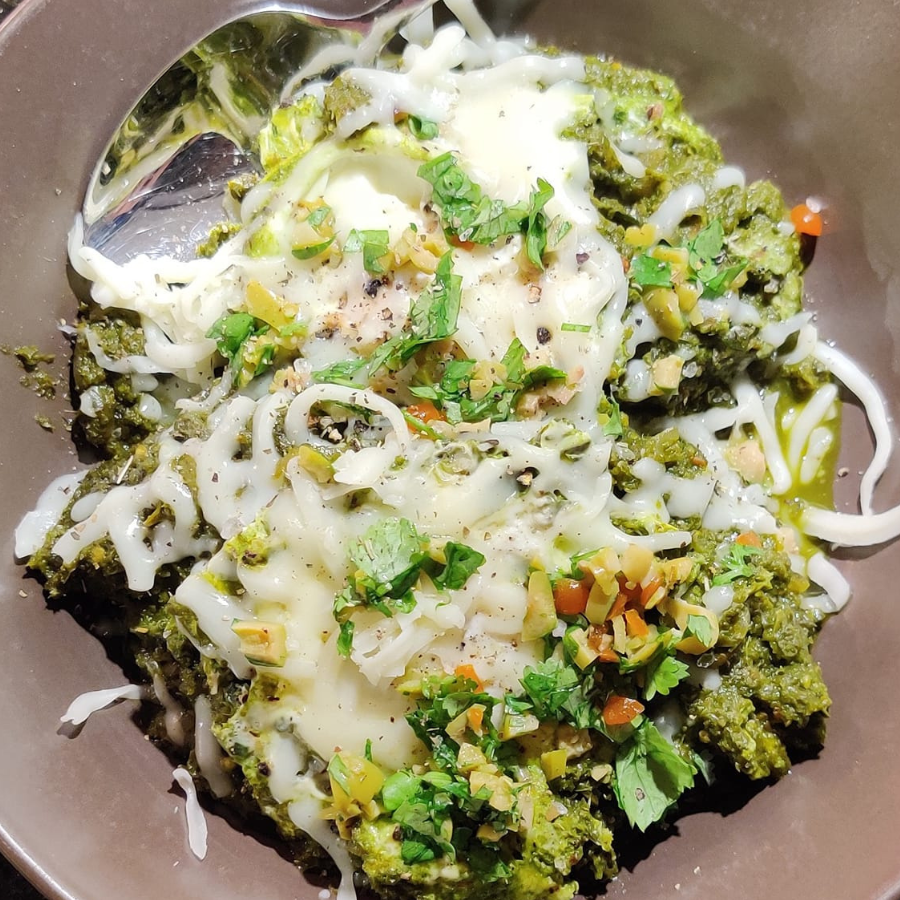
Clara Eckel used this greens exit strategy to create “Green Eggs and BAM!” Base is sautéed onions and tomatillos blended with a roasted Jalapeño to make a simmer-sauce. To that she added blanched-then-blended puree of all the collard greens from this week, kale from garden, cauliflower and broccoli leaves, cilantro stems and leaves with broth and green olive brine. Added everything to skillet and then spiced things up with smoked paprika, cumin, coriander and nutmeg, cracked my eggs, covered and called it dinner!
WEEK 15 ANNOUNCEMENTS
- Sign up for the free Pumpkin Hunt ~ October 9th, 7:30-9:15 PM. CSA members only. The hunt starts around 8 PM when it’s dark enough, and takes about 10 minutes! After the hunt, we have 2 campfires burning, and you’re welcome to set up your chairs and enjoy the fire. Bring some skewers and smores fixing to roast marshmallows. And enjoy some donuts and cider on us! Kids can play on the swingset or sandbox or just run around our lawn! Please RSVP here so I can get enough snacks.
- Who were the winners of the Clean Out the Fridge Challenge? Congratulations to Elizabeth Tore, Courtney Flanders, and Amy Damschroder!
- When can I sign up for next year?!… We will be opening the doors to pre-registration for next summer season on October 16th. We give all our current members and Sampler members first dibs on the full-season spots for next year. You will have until October 22 to renew, before we open them to our wait list. Look for next year’s pricing and sign up details in a few weeks.
- You can order additional items from the Shared Legacy Farms online store. Our store link is super easy to remember: www.sharedlegacyfarms.com/store. Just be sure to select the right pickup site that coincides with your pickup location. If the pickup option is greyed out or not available, it means you missed the window to order. You need to place your order 36 hours before your site. We harvest the product on Monday and Wednesday mornings — early. This week, the store will have: green beans, pints of mini garlic, Delicata winter squash, honey-nut squash, butter-baby squash, Heart of Gold winter squash, Spaghetti squash, Mizpuna greens, Mild n Wild greens, Esme arugula, dandelion greens, cutting celery herb, bunched celery, Tokyo Bekana greens, sweet banana peppers, collards, bulk canning tomatoes (final week), sweet corn (final week), bulk sweet corn, red and orange Italian fry peppers (quart), mini red bell peppers, jalapenos (green or red), Diana radishes, Icicle radishes, ground cherries, shishitos, tomatillos, All-star kale, dino kale, kohlrabi, small yellow or red onions, Jonathan apples, Jed’s eggs, honey, local maple syrup.
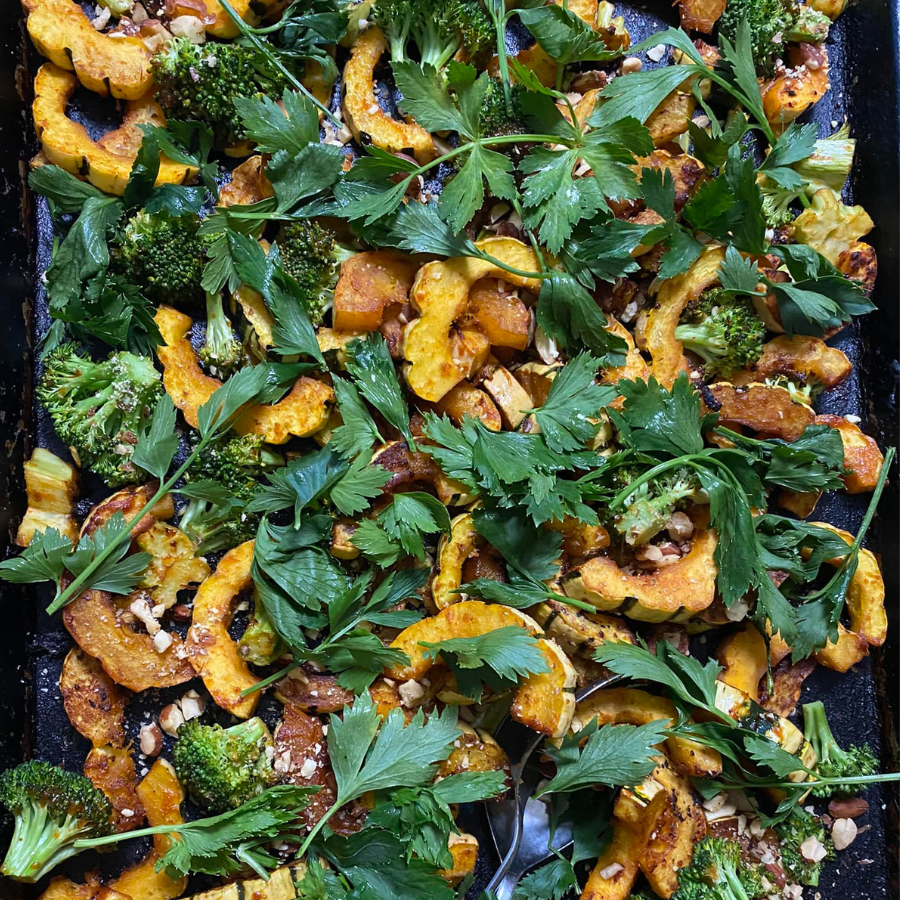
Miso-Harissa Delicata Squash and Brussels Sprouts Salad by Ellen Rodriguez. She subbed broccoli for the brussels sprouts and cutting celery for the cilantro.
WEEK 15 CSA RECIPES
Members: You can download these recipes as a PDF.These recipes are designed to inspire you to use your box this week! Please check inside our private Facebook group to find your fellow members sharing ideas for what to make with their box! Share a photo and you might be featured in next week’s newsletter!
Crispy Tokyo Bekana Salad
The Best Baby Kale Salad
Honey Ginger Asian Greens
Garlic Risotto
Rustic Potato Leek Soup
Baked Spaghetti Squash with Creamy Roasted Red Pepper Sauce
Spaghetti Squash Cheddar Bites
Roasted Kohlrabi with Lemon Shallot Vinaigrette
Potato and Leek Gratin
Poblano Cream Sauce
Sneaky Kohlrabi & Cheese Fettuccine
Apple Sangria
Cider Wassail
Red Wine Poached Pears

